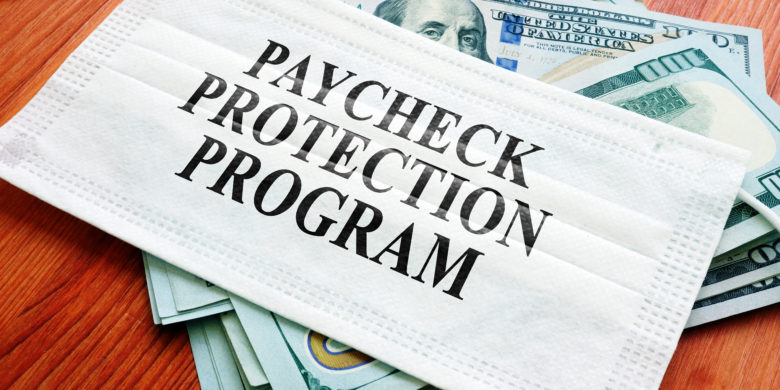
On August 4th, the SBA issued additional guidance on the PPP loan forgiveness calculations in the form of a FAQ sheet. Click here to access the full SBA document. We have highlighted some of the key points below.
General
- Sole proprietors, independent contractors, or self-employed individuals with no employees (no employees at the time of application as well) should complete the Loan Forgiveness Application 3508EZ.
- Borrowers must submit their forgiveness application within 10 months of the last day of the covered period. The borrower is not required to make any payments on the loan until the forgiveness amount is remitted to the lender by the SBA.
- If the borrower receives full forgiveness, no payments are due.
- If the borrower does not receive full forgiveness, the remaining balance must be paid by the borrower by the maturity date of the loan, including any accrued interest from the receipt of the loan to the date of any SBA forgiveness.
Payroll Costs
- Payroll costs incurred prior to the covered or alternative period but paid within the covered or alternative period are eligible for forgiveness. In addition, payroll costs incurred during the covered or alternative period but paid after the last date of the covered or alternative period are also eligible for forgiveness. This applies to only payrolls paid bi-weekly or on a more frequent basis.
- Example 1 – Covered period April 20th – Oct 4th with the first payroll period ending April 18th, paid April 24th. The payment on April 24th is within the covered period and eligible.
- Example 2 – Covered period April 20th – Oct 4th with the last payroll period ending Oct 4th, paid Oct 9th. The payment on Oct 9th is outside of the covered period, but eligible.
- Borrowers paying payroll less frequently than bi-weekly, such as semi-monthly or monthly, will need to calculate payroll costs for partial pay periods.
** Reminder the covered period or alternative period cannot extend past December 31, 2020.
- Payroll costs include all cash compensation including salaries, tips, commissions, bonuses, and hazard pay up to $100,000 on an annualized basis.
- The employer portion of health care benefits paid or incurred by the borrower during the covered or alternative period is eligible for forgiveness, as long as premiums are paid prior to the next premium date. The employee’s share of health insurance withheld from pay is not included for forgiveness.
- Forgiveness is not provided for employer contributions for retirement benefits accelerated from periods outside the covered or alternative period.
- Compensation for owners of a business are capped at $15,385 if using the 8-week covered period or $20,833 for the 24-week covered period. Forgiveness varies by the type of business:
- C Corporation
- Compensation up to 2.5/12 of his or her 2019 cash compensation (limited to $100,000 of 2019 compensation).
- Employer state and local taxes paid by the borrower.
- Employer contributions for their health insurance.
- Retirement contributions capped at 2.5/12 of the 2019 employer retirement contribution.
- S Corporation
- Compensation up to 2.5/12 of his or her 2019 cash compensation (limited to $100,000 of 2019 compensation).
- Employer state and local taxes paid by the borrower
- Retirement contributions capped at 2.5/12 of the 2019 employer retirement contribution.
- Employer contributions for health insurance is not eligible for owner/employees with at least a 2% stake in the business, including employees who are family members of at least 2% owner.
- Self-employed Schedule C (includes sole proprietors, self-employed individuals, and independent contractors)
- Compensation is limited to up to 2.5/12 of his or her 2019 net profit as reported on IRS Form 1040 Schedule C line 31 (limited to $100,000 of 2019 compensation).
- For a new business, estimate 2020 Schedule C.
- Unlike C Corporations and S Corporations, employer state and local taxes, retirement contributions, and employer contributions for health insurance are not eligible for forgiveness.
- Compensation is limited to up to 2.5/12 of his or her 2019 net profit as reported on IRS Form 1040 Schedule C line 31 (limited to $100,000 of 2019 compensation).
- General Partners
- Compensation is limited to 2.5/12 of their 2019 net earnings from self-employment that is subject to self-employment tax, which is computed from 2019 IRS Form 1065 Schedule K-1 Box 14a (reduced by Box 12 Section 179 expense deduction, unreimbursed partnership expense deduction on their IRS Form 1040 Schedule SE, and depletion claimed on oil and gas properties) * 0.9235 (limited to $100,000 of 2019 compensation).
- Employer state and local taxes, retirement contributions, and employer contributions for health insurance are not eligible for forgiveness.
- C Corporation
Non-Payroll
- Interest on loans secured by a mortgage on real or personal property is eligible for forgiveness (includes auto loan).
- Leases and mortgages in place prior to February 15, 2020, and renewed subsequent to that date are considered as existing prior to February 15, 2020, and, therefore, eligible for forgiveness.
- Transportation fees refers to the transportation or utility fees assessed by state and local governments.
Loan Forgiveness Reductions
- Borrowers are not subject to an FTE reduction in the following circumstances:
- Inability to rehire individuals who were employees of the borrower on February 15, 2020 (such as employee declined an offer to return to work).
- Inability to hire similarly qualified individuals for unfilled positions on or before December 31, 2020.
- Employers will need documentation such as written offer to rehire an individual, written record of the offer’s rejection, written record of efforts to hire similarly qualified individual.
- To calculate the reduction in forgiveness for reductions in employee salary or hourly wage:
- Employee works the same hours at reduced pay.
- Total salary reduction over the 25% threshold * 8- or 24-week period used for forgiveness / 52 weeks.
- Example – $52,000 salaried employee reduced to $36,400 while working the same hours using a 8-week covered period
- Total reduction = $15,600
- 25% reduction original salary = $13,000
- Excess reduction = $2,600 ($15,600-$13,000)
- $2,600 * 8-week covered period / 52 = $400 forgiveness reduction
- If the reduction is restored by December 31, 2020, there is no forgiveness reduction.
- A reduction in forgiveness does not apply to an hourly employee whose hours have decreased during the covered period. The reduction applies only if their hourly rate was decreased by more than 25%.
CironeFriedberg CironeFriedberg’s primary client base is in Connecticut and neighboring Dutchess, Putnam, and Westchester counties in New York. The firm was established in 2016 with the merger of Bethel-based Equale & Cirone, LLP, established in 1999 and Bridgeport-based Friedberg, Smith & Co., PC, founded in 1945. Services include: Tax, Accounting & Assurance, Consulting, Forensic Valuation and Litigation Support.
If you have any questions, please call your CironeFriedberg professional. You can reach us by phone at (203) 798-2721 (Bethel), (203) 366-5876 (Shelton), or (203) 359-1100 (Stamford), or email us at info@cironefriedberg.com.





Leave a Reply